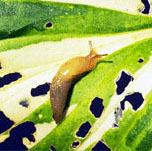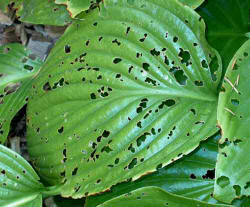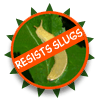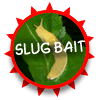 |

Slugs and, to a lesser extent, snails are the
nemesis of
hosta gardens. A shade garden is the
ideal environment for these critters so they tend to
thrive along with the hostas.
At this point in time, there is no single,
all-effective way to eliminate slugs in the hosta
garden. In order to gain some level of control over
slugs, you need to attack them at one (or more) of
three points:
- Get Rid of the
Slug
- Change the Growing
Environment
- Reduce the Food
Supply
- Mr PGC Slugs
vs Hostas Rating
|
 |
 There are probably a hundred different
(home remedies) approaches to getting rid of some of the slugs in
your hosta garden. All of them seem to work to a
certain extent but none of them do the job totally.
Here are a few of the more common approaches: There are probably a hundred different
(home remedies) approaches to getting rid of some of the slugs in
your hosta garden. All of them seem to work to a
certain extent but none of them do the job totally.
Here are a few of the more common approaches:
-
Trap Them
- We have all heard about placing a tray of old
beer at soil level. The slugs crawl in and
drown. They are actually after the yeast so
baker's yeast may also work.
Place some pieces of wooden board in the area with
the slugs. During the heat of the day, turn the
boards over and kill the slugs with a mixture of
one part bleach to nine parts water. Some people
use vinegar and other low toxic materials to
kill them. Be careful in the over use of salt in
the garden.
Take a roll of newspapers and put a rubber band on
it. Soak it in a pail of water for a few hours.
Take off the rubber band and lay the newspaper
in the slug area. They will crawl between the
pages of the paper. Roll it up and dispose of
the paper and slugs on page 4.
-
Direct Killing
- Spray the slugs with the dilute bleach
solution directly on the plant. The downside of
this is that the critters feed at night. Use a
flashlight to find them but be sure to tell your
neighbors what your are doing. Explaining to a
non-gardening policeman can be embarrassing.
-
Exclusion
- There are several ways to prevent slugs from
moving from plant to plant in your garden. Since
they are soft bodied creatures, they do not like
to crawl across any rough surfaces.
You can spread things like wood ashes, crushed egg
shells, diatomaceous earth, cinders and other
coarse materials around the base of the plants.
The down side is that, after a few rains, these
materials may lose their effectiveness. They
also do not stop the slugs that are already on a
particular plant.
Copper ribbon is now available in most gardening
catalogs. Cut it into pieces and place it around
the base of especially valuable specimen plants.
When the slug attempts to cross the copper
strip, it gets a galvanic response which give it
a little tingle.
-
Poisons
-
There are a few pesticides that are specifically
labeled for slug control. A common one comes in
the form of a granular bait which, when eaten by
the slug, causes it to lose its ability to
produce slime. Another one is based on
iron
phosphate and, may have some fertility effect
for the plants too.|
In Great Britain, a parasitic nematode is
available. Unfortunately, this material is not
yet legal for use in the
United States. Some people have
purchased this material while on a visit to
England and have used in their gardens. This
could be great or it could be very dangerous.
In the U.K. it appears that the nematodes only
affect slugs. However, until studies are done in
North
America, we do not know what other species
may be affected here. Most of the very serious
horticultural insects (gypsy moth,
Japanese
beetles,
European chafer, etc.) and diseases
(Dutch elm disease,
chestnut blight, etc.) have
been inadvertently imported from other parts of
the world.

|
|
 |
 |
To thrive, slugs need a cool, moist environment
preferably with plenty of decomposing organic
matter. If you have slugs, then you have the proper
environment for them to feed, reproduce and survive.
The number of slugs you have is determined by how
well your environment fits the needs of the slug.
Water - In
general terms, the wetter your garden, the
greater the slug population. Hostas need a fair
amount of water to thrive but many people use
far too much irrigation water. The use of
organic matter incorporated into the soil will
help minimize the need for a lot of irrigation.
The key here tends to be finding a balance where
you water enough to keep the hostas happy but
not so much that the slugs go wild.
Mulch
-
Wood chips, shredded bark, cocoa bean hulls and
other organic mulches provide a lot of benefits
in the garden. However, they can also be a great
home for slugs. If you have a slug problem,
avoid using too much mulch. When the mulch
begins to rot and stays moist all the time, rake
it off and put it in the compost bin. Replace it
with a thin layer of fresh mulch. This will dry
out quicker after rains and make it less
inviting for slug families.

|
 |
 Although it seems hard to believe sometimes,
slugs have preferences in what they eat just
like any other creature. So, you can choose to
plant only those hostas that do not seem to be
bothered by slugs. The tough part is determining
which hostas fall into this category. Although it seems hard to believe sometimes,
slugs have preferences in what they eat just
like any other creature. So, you can choose to
plant only those hostas that do not seem to be
bothered by slugs. The tough part is determining
which hostas fall into this category.
There are lists and lists of hostas that are
either always eaten by slugs or never eaten.
Sometimes the same cultivar will appear on both
lists. How do you know what to do?
Well, generally, the thicker the texture of the
leaf, the lower the level of slug damage. Thin
textured hostas, often the highly variegated
types, tend to be most desirable for our legless
friends.
You may have to develop your own list of
slug-resistant hostas for your own garden. The
available lists will give you an idea but will
not be fool proof for your conditions. Your
shade may be darker, soil less well drained,
irrigation practices more liberal and mulch
layer thicker than the average garden. These
will created a better environment for the slugs
resulting in damage to cultivars that are
normally not bothered.
We have tried to categorize hostas in terms of their
susceptibility to slug damage under typical growing
season conditions.

|
 |
As part of the hosta cultivar listings in our
HostaHelper website, we have given ratings to
certain plants according to the level of damage
often encountered as follows:
|
 Hosta
cultivar descriptions that include this button
are those that are considered
resistant to damage
by slugs. Generally, these hostas have thick or
above average substance i.e. texture or
thickness of the leaves. Although they are not
immune to damage, under general garden
conditions, they usually come through the season
unscathed. However, if you build a great
environment for slugs (i.e. excessive mulch and
irrigation), they too may be damage. Hosta
cultivar descriptions that include this button
are those that are considered
resistant to damage
by slugs. Generally, these hostas have thick or
above average substance i.e. texture or
thickness of the leaves. Although they are not
immune to damage, under general garden
conditions, they usually come through the season
unscathed. However, if you build a great
environment for slugs (i.e. excessive mulch and
irrigation), they too may be damage.
|
 Cultivars
with the "Slug Bait" button are those that tend
to be damaged the most by slugs during a typical
growing season. Usually, this relates to the
thickness i.e. substance or texture of the
leaves. Those with thin, tissue paper like
leaves tend to be the ones first attacked by
slugs. Again, if you maintain a poor environment
for slugs (i.e. minimize rotting mulch and
control irrigation), these cultivars will
experience less damage. Cultivars
with the "Slug Bait" button are those that tend
to be damaged the most by slugs during a typical
growing season. Usually, this relates to the
thickness i.e. substance or texture of the
leaves. Those with thin, tissue paper like
leaves tend to be the ones first attacked by
slugs. Again, if you maintain a poor environment
for slugs (i.e. minimize rotting mulch and
control irrigation), these cultivars will
experience less damage.

|
|



